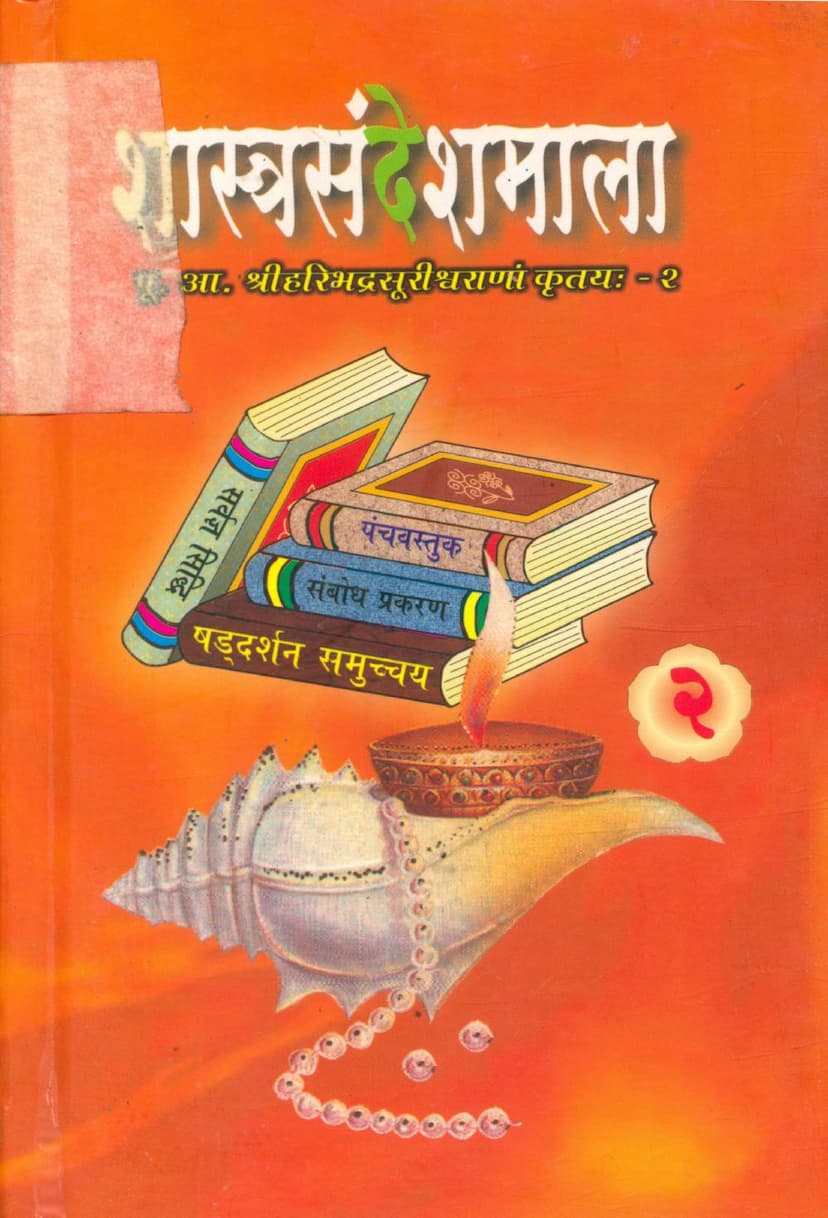Shastra Sandesh Mala Part 02
Added to library: September 2, 2025

Summary
This is a comprehensive summary of the Jain text "Shastra Sandesh Mala Part 02" authored by Vinayrakshitvijay, published by Shastra Sandesh Mala. The text is a collection of works by Acharya Shri Haribhadrasurishwarji Maharaj.
Key Information about the Book:
- Title: Shastra Sandesh Mala Part 02
- Author: Vinayrakshitvijay (Disciple of Panyas Shri Bodhiratnavijayji M. Sa., who was a disciple of Acharya Bhagwan Shri Mad Vijay Ramachandrasurishwarji)
- Publisher: Shastra Sandesh Mala, Surat
- Content Focus: This volume primarily contains works by Acharya Shri Haribhadrasurishwarji Maharaj, with seven of the twenty books in this series attributed to him and Upashri Yashovijayji Maharaj. The remaining thirteen books feature works by various authors on different topics.
- Date of First Edition: Vijay Dashami, Vikram Samvat 2061 (2004 AD)
- Price: ₹40/- (at cost)
- Revison and Proofreading: A dedicated team of Panyas Shri Vijay Vilshekhar Surishwarji M. Sa.'s disciples, including Panyas Shri Hithrakshitvijayji M. Sa. and Sadhavi Shri Bhadrajnashriji M., along with Pandt Shri Ratibhai Chimanlal Joshi, ensured the accuracy and correctness of the texts.
- Special Note: Parts 1 to 20 of Shastra Sandesh Mala were published using "Jnana Dravya" (knowledge funds).
Core Thematic Content (Based on the provided text, particularly the table of contents and initial verses):
The text appears to be a compilation of significant Jain philosophical and practical works, focusing on:
-
"Panchvatthugam" (पंचवत्थुगं): This section (pages 10-47) seems to be a foundational text in Prakrit, likely outlining the five essential entities or topics in Jainism, perhaps related to the path to liberation. The verses discuss concepts like:
- Pravajya (पवज्जा): Renunciation, its conditions, and the qualifications for initiation. It details the importance of a qualified guru, the disciple's conduct, and the benefits of following the path.
- Aacharya (आचार्य): The role and importance of the spiritual preceptor in guiding the disciple.
- Anuvartana (अणुवत्तना): The practice of following the guru's teachings and guidance, emphasizing its importance for spiritual progress.
- Conduct and Discipline: Numerous verses detail the proper behavior, adherence to vows, and the avoidance of transgressions for monks and nuns.
- Karma and Liberation: Concepts related to the shedding of karmic burdens and the attainment of liberation are touched upon.
- Daily Rituals and Practices: The text describes various daily observances, rituals, and ethical guidelines for ascetics, including details on purification, begging (Esana), contemplation, and interaction within the monastic community.
- Virtues: The importance of virtues like non-violence, truthfulness, non-possessiveness, purity, and knowledge is highlighted.
- Philosophical Debates: Sections seem to touch upon refuting other philosophical schools and establishing the validity of Jain principles.
- The Path to Moksha: The ultimate goal of liberation and the steps involved, including the significance of the right faith, knowledge, and conduct, are discussed.
-
"Sambodh Prakaranam" (संबोधप्रकरणम्): This section (pages 153 onwards) likely focuses on enlightenment, right understanding, and the path to spiritual awakening. It discusses:
- The Nature of Reality: Explaining the Jain perspective on soul (jiva), non-soul (ajiva), karma, liberation, and other fundamental principles.
- The Role of the Tirthankaras: The teachings of the Tirthankaras as the guiding light for spiritual pursuit.
- The Path of Practice: Emphasizing the practical application of Jain philosophy in daily life, including the importance of righteous conduct, devotion, and penance.
- The Goal of Moksha: The ultimate aim of escaping the cycle of birth and death and attaining eternal bliss.
-
"Sarvajna Siddhih" (सर्वज्ञसिद्धिः): This part likely deals with the proof and justification of omniscience (Sarvajnatva) in Jainism, a central tenet. It might involve:
- Arguments for Omniscience: Presenting logical and philosophical arguments to establish the existence and attainability of omniscience by the liberated souls (Siddhas) and the Tirthankaras.
- Refutation of Counterarguments: Addressing and refuting potential objections or alternative viewpoints from other philosophical systems regarding omniscience.
-
"Shaḍdarshana Samuchchaya" (षड्दर्शनसमुच्चयः): This section likely provides a concise overview and comparison of the six principal heterodox (non-Jain) philosophical schools, possibly presenting the Jain perspective on their doctrines and refuting them. The summary includes:
- Buddhism: Discussing the concepts of the Four Noble Truths, impermanence, and the path to Nirvana.
- Nyaya: Covering the theories of logic, proof, and the twelve categories (prameyas).
- Samkhya: Explaining the dualistic philosophy of Purusha (consciousness) and Prakriti (matter), and their twenty-five evolutes.
- Vaisheshika: Detailing the atomic theory, causality, and the six categories.
- Mimamsa: Discussing Vedic injunctions, dharma, and ritualistic practices.
- Charvaka (Lokayata): Presenting their materialistic and atheistic views, emphasizing sensory experience and denying the afterlife or spiritual realities.
Overall Purpose and Significance:
The "Shastra Sandesh Mala Part 02" serves as a valuable resource for understanding key Jain philosophical concepts, ethical guidelines, and practical spiritual disciplines. It showcases the profound teachings of Acharya Haribhadrasurishwarji, a highly respected scholar and ascetic, and presents them in a structured and accessible manner. The compilation aims to disseminate this knowledge for the spiritual benefit of Jains and interested individuals, encouraging adherence to the path of righteousness and the ultimate goal of liberation. The detailed categorization of ascetics' conduct and various practices reflects the meticulousness of Jain scriptural traditions.